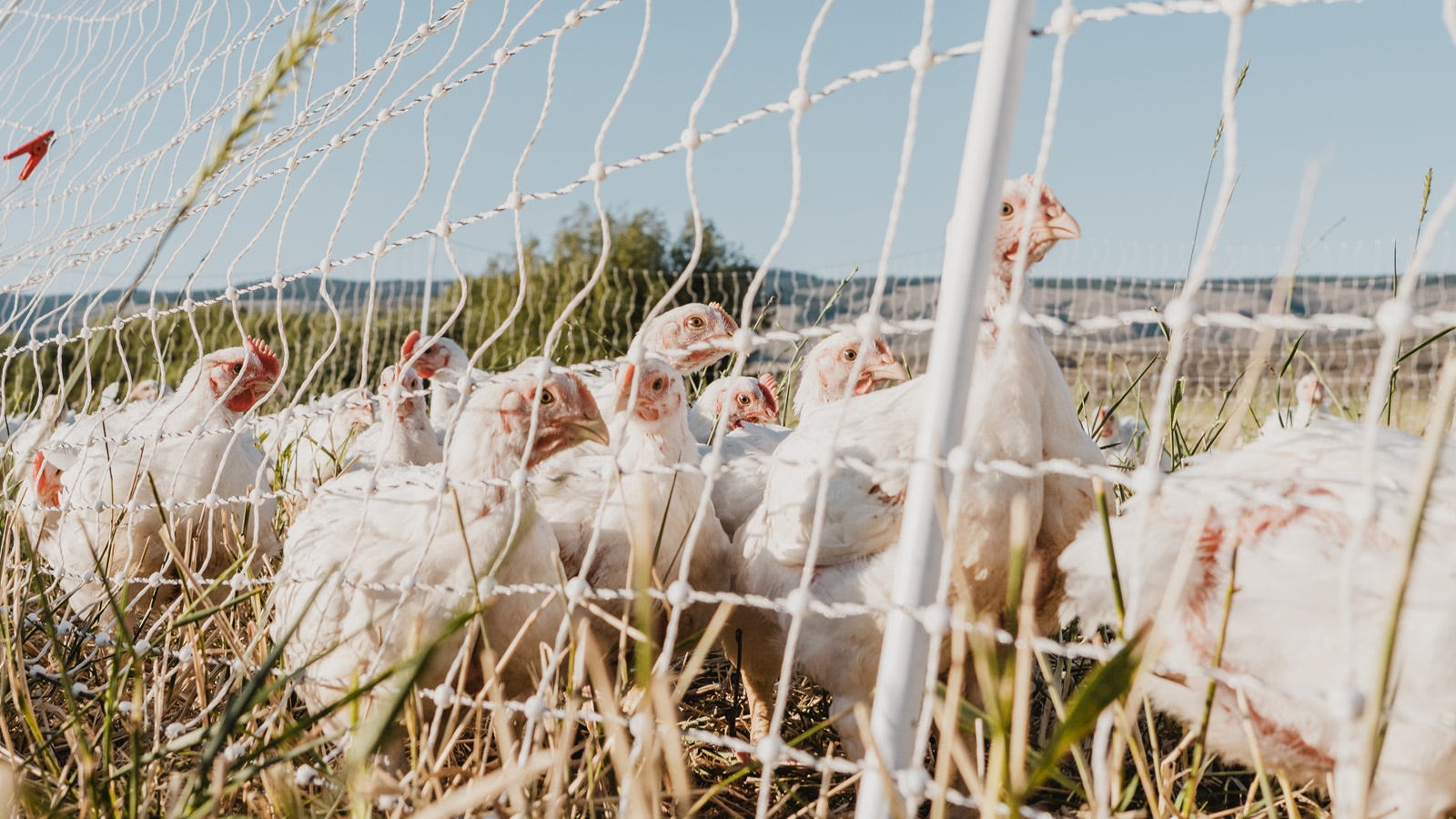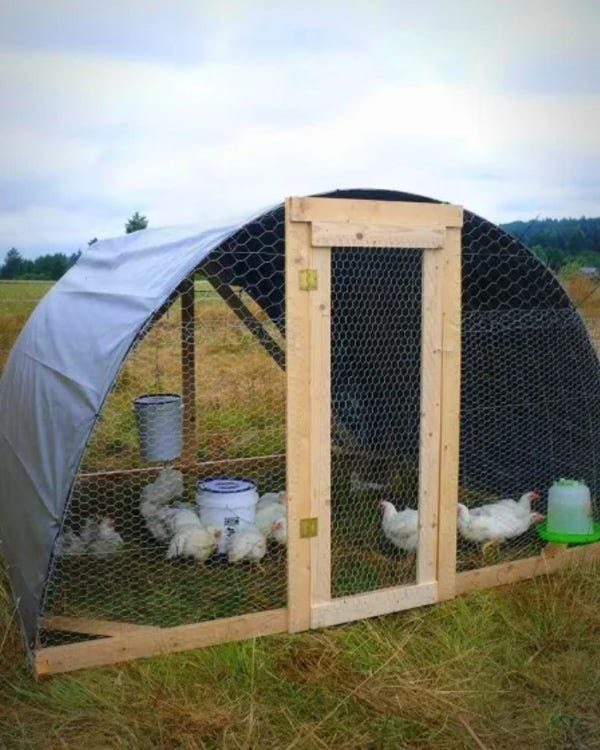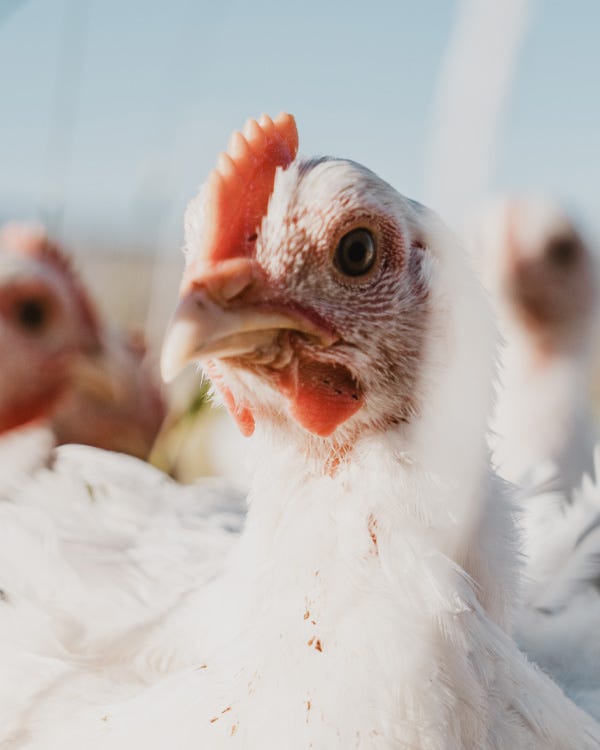Raising Cornish Cross in Chicken Tractors

Developed for the commercial poultry industry cornish cross chickens, a broiler breed, have earned a poor reputation as a glutinous, lazy breed that suffers from a variety of health problems.
Having now raised this breed, annually, for the past five years—in the sunshine, fresh air, and on green grass—I can confidently say this reputation is undeserved. Joel Salatin popularized raising these broilers outdoors in chicken tractors. My wife and I have adopted much of Salatin's methods and tweaked them to fit both our country and urban lifestyle depending on where we were living at the time. We found that raising cornish cross in the open air and moving them onto fresh forage each day eliminates disease, crowding, and the health problems so deeply associated with this breed.
There is an ever expanding range of broiler breeds on the market including dual-purpose breeds, heritage, and rangers, but cornish cross are still my favorite meat bird. No other breed converts feed-to growth better than the cornish cross. Feed-to weight conversion can approach 2:1. We harvest most of our birds at eight to nine weeks in age and most weigh 5-7 pounds once processed. Other breeds take on average four weeks longer, or more, to reach similar slaughter weights, which translates to greater feed costs and loss of free time in the spring and summer months. Additionally, cornish cross are a very docile breed, which makes them easy to handle. That’s handy when it comes time to slaughter, or if you get a wayward bird that decides to explore a neighbor’s property or your garden. They also integrate well into layer flocks and we have had no issues letting our layers and broiler flocks merge on the lawn while we tend the garden on warm afternoons. The process of raising cornish cross is relatively simple if you follow the following formula.


Week 1
As with raising any other chicks you should have your brooder up and running with food, water, and a heat lamp before you go to the store and buy your chicks. At the store look for the healthy energetic chicks. I like the chicks with their heads buried in the feed trays or running around actively. We use newspaper as their bedding material for the first few days until they learn what food looks like—they have a habit of excessively gorging themselves on pine shavings that can lead to choking. Once you get the chicks home ensure the temperatures in the brooder are meeting their needs. If they cluster under the heat lamp they are probably cold. Minimize drafts and lower the heat lamp. If they avoid the area under the heat lamp and cluster on the edges of the brooder, they are likely too warm and you need to raise the heat lamp. Provide them with 24 hours access to 20-22 percent crumble or mash feed in the first week. You may choose medicated feed, but as long you keep the brooder clean, dry, and warm it really isn't necessary. By day two I start chopping up dandelion leaves or salad greens and sprinkling it on their food and water. I also throw any wayward bugs or spiders in the brooder and watch them tear it apart like a school of piranhas. If you provide them with greens or insects be sure to sprinkle some chick grit in their feed.
Weeks 2 and 3
Continue to feed them 20-22 percent feed, but provide your birds access to feed for only 12 hours of the day. If you let them eat too much at this stage they can grow too rapidly, which can lead to health issues later on. In the mornings I like to coarsely tear up dandelions or other greens, if I have access to them, and dump them in the brooder before giving them their feed. It's fun to watch them play tug of war with dandelion leaves and helps them identify greens as food. As their feathers grow, slowly inch the brooder light upward to help build cold tolerance, but watch for behavioral clues that suggest birds are getting too cold and manage brooder temps accordingly.
This is a good time to think about assembling your chicken tractors. Salatin uses a square design that holds up to 50 birds. However, for our pastured poultry operation, we opted for a taller model that we could walk in and more easily access feeders, waterers, and birds. This model uses an 8' by 10' base constructed using 2x4s with two cattle panels forming a hoop frame that’s stapled to the base. One end gets a support beam and is covered with chicken wire, while the other gets framed with a door and similarly covered in chicken wire to keep predators out. A 16’ X 10' tarp forms the walls and roof and a heavy gauge rope is attached to the front to make it easy to drag the tractor. Feeders and nipple waterers are hung from the roof using S-hooks and chains or rope. We run 20-30 birds in each of these tractors. However, tractors need not be as elaborate or large especially for smaller broiler flocks. On our 1/16th acre micro-farm, we raised a spring and fall batch of broilers of five to six birds each, in a chicken tractor that consisted of two screen doors attached, with a removable tarp roof. The main thing a chicken tractor needs to do is keep predators at bay and protect the broilers from rain and direct sun exposure, as they overheat easily.
Week 4
At four weeks transition the birds to an 16-18 percent protein all-purpose poultry feed and only provide access to feed 12 hours a day. Once birds are fully feathered and lows are not dipping below 45 F it's time to transition the birds outside. They can tolerate colder temperature, but ensure to minimize drafts. You can add an additional tarp or plastic to the tractor for added protection, and ensure the grass is dry. You can use heat lamps, or if have a small flock you can pull them in at night until warmer temperature prevail. During intense heat ensure that the birds are getting plenty of fresh air and orient the tractor to maximize shade and exposure to breezes. You can also wet the grass under the chicken tractors, which stimulates the birds to roll around in the wet grass to cool off.
Each morning you should move the chicken tractor onto fresh grass. Areas with lots of tender new growth, such as those recently mowed or grazed, are ideal and the birds will gleefully destroy dandelion greens on urban lawns. When moving your chicken tractors be sure that none of the chickens get their legs caught up on the base as it slides. They do a good job of letting you know if they do get their leg or foot caught. I give the birds an hour or so of eating fresh greens before I give them their feed.
Weeks 5 through 8
Move birds daily onto fresh grass and provide with fresh, clean water. Reduce access to 16-18 percent protein all-purpose poultry feed to four to six hours per day. This reduces excessive growth, which can result in cardiac and respiratory issues and also encourages foraging on greens. You can feed birds chicken-friendly scraps from the kitchen or during the fall they love any apples, plums, or other fruits that have fallen to the ground. Unlike factory farm birds these 6-10 pound birds will be very active although really large roosters will be a little more sluggish than lighter hens. We will occasionally open the tractor up on days we are working outside and let the birds free-range. They seem to enjoy taking short flights and chasing each other across the lawn or interacting with our free-range layers. They can easily be coaxed back to the tractor in the evening with food.


Week 8 or 9
Birds are maintained on 16-18 percent protein feed for four to six hours a day. If you have the space you can move them twice a day to increase access to fresh greens. We typically slaughter all of our birds during this period. There is no substantial weight gain beyond nine weeks and we are already busy with gardening, fishing, and just enjoying the lazy days of summer. Twenty-four hours prior to slaughter we stop feeding to keep things as clean as possible during evisceration.
Raising your own broilers is a rewarding adventure and in a short two months you will be filling your freezer with delicious, healthy low-fat meat. In my opinion pasture/lawn raised broilers taste far superior to anything you'll buy at the supermarket. The meat has a more complex flavor and healthier color, likely a result of exercise and diet differences enjoyed by your birds versus factory birds. Also there is a certain satisfaction gained from raising your own food. Fire up the chicken tractor this coming year and fill the kitchen with the aroma of a home-grown roasted bird for the family to enjoy.
I've seen 1.5-2sf per bird, or more.





